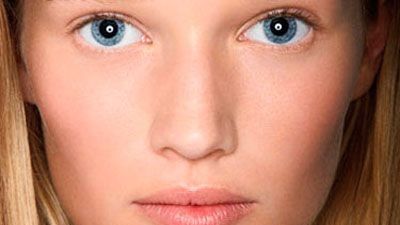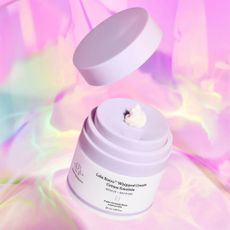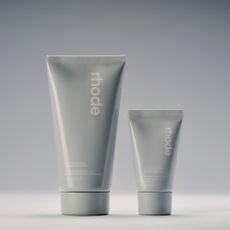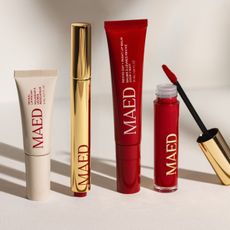Is Your Skin Hormonal?
Zits. Brown spots. Sagging. Forget PMS—now you can blame your hormones for bad skin, too.

Up until your 30th birthday, you lose about a million skin cells every 40 minutes. Sounds gross, but this desirable sloughing is actually what gives you the dewy skin that radiates youth. "For the first few decades, your epidermis renews itself every 30 days, but by the time you're 40, it takes about 45 days," says Dr. Kathy Fields, assistant clinical professor of dermatology at UCSF. Unfortunately, this shedding slowdown is a reflection of your body's gradual aging process. Long before menopause, the same hormonal production shifts that sap your fertility will start showing their signs on your face. But before you start stockpiling your pantry with soy and estrogen supplements (which may raise your risk of breast cancer because of their systemic effects), try treating your hormonal skin issues safely, from the outside in.
Breakout Role
Just as you may see a little thinning in your hairline or the slight shadow of a moustache, more blackheads and blemishes are a sign of aging. "About a third of women will get adult acne, usually in their early 30s, even if they didn't have breakouts when they were younger," says Beverly Hills dermatologist Dr. Stuart Kaplan. "Starting in your late 20s, estrogen levels decline faster than testosterone." Because testosterone is an androgenic hormone, it increases masculine qualities (hence the new facial hair) and boosts oil production, plugging your pores and causing blemishes. The difference between adult acne and the teenage type? Small red bumps (not painful, cystic pimples) are more common when you're older, according to Kaplan, and acne along the jawline or around the mouth are a telltale sign that you're dealing with a hormonal breakout. Going on the birth-control pill or spironolactone (a diuretic with antiandrogenic effects) will balance hormone levels and reduce breakouts. For a nonprescription approach, try combination acne-and-wrinkle-fighting formulas that gently keep skin clear without over-stripping.
See Spot, Run
Even if you haven't had a baby, brown, patchy melasma (aka the mask of pregnancy) can appear if you take birth-control pills. "Estrogen turns on melanin pigment production, so being on the Pill can be a trigger," explains Fields. "If you're genetically prone to melasma, you'll have brown spots, even if you stop taking the Pill." Since pigment problems are notoriously difficult to treat, Fields recommends strict sun avoidance and a cocktail of antioxidants and sunscreen to keep dark dots at bay.
Dry Spell
Thyroid function naturally peters out over time, which means less hormone production overall. But many women are diagnosed as hypothyroid during or after pregnancy. "When your thyroid function is low, skin becomes dry and scaly," explains Miami dermatologist Dr. Fredric Brandt. He also notes that the epidermis starts losing moisturizing hyaluronic acid when you hit your late 20s. Since estrogen enhances hyaluronic acid production, declining estrogen levels mean less moisture. Kaplan describes the result: "Your skin becomes leathery and starts to crack like an old raincoat. The purpose of skin is to act like a barrier. As your face gets drier, it also gets more sensitive." The good news is that you can replenish hyaluronic acid topically. Sealing in serums with a cream will protect against irritation and further moisture loss.
Stay In The Know
Get exclusive access to fashion and beauty trends, hot-off-the-press celebrity news, and more.
Timelines
Estrogen is stored in fat, so severe dieters will look older, faster, warns Fields. Aside from hyaluronic acid production, estrogen also affects collagen and elastin levels. And hormonal dips thin the skin, making it less pliable and more prone to wrinkling. "After age 30, you're losing 1 percent of your collagen a year," says Fields. "Peptides, growth factors, and retinols will help rebuild the collagen, but elastin is difficult to replace." Elastin is responsible for—you guessed it—elasticity, so skin becomes looser and less flexible over time. "Facial wrinkles occur when the skin becomes too big for the tissue underneath," explains Kaplan. The first place you'll start seeing fine lines is around the eyes (the periorbital region), where skin is the thinnest. When peptide-fortified eye and face creams are no longer enough, Kaplan recommends lasers and injectable fillers to plump out the padding.
Slacking Off
In the decade leading up to menopause, testosterone finally drops as much as estrogen. You'll see less acne, but the deepest layers of your skin will start to thin and sag. Also, early hormone-related bone loss collapses facial structure, squaring off formerly rounded eye sockets (causing dark circles under the eyes) and increasing skin slackening. Going on and off the Pill makes things worse, warns Fields: "Skin looks more juicy when you're on the Pill, but if you're playing around with it, your face will get dehydrated and drop earlier." However, topical applications of plant-derived estrogens (phytoestrogens like soy, green tea, and wild yam) are safe and can help firm up the face. "If you start applying phytoestrogens in your 40s," says Boston dermatologist Dr. Ranella Hirsch, "I'd bet money that it would help prevent much of the sagging that occurs after menopause."
Once hormone production grinds almost to a halt (hello, menopause!), skin changes dramatically all over your body. "Thirty percent of your collagen is lost in the first five years after menopause. As a result, not only will your face fall, but you'll also see more cellulite—your hormones are gone and your body turns to Jell-O," says Fields. "Forty-year-olds still look good, but even Demi Moore will turn to gush." Stay tuned for Demi's solution (because you know that at age 47, she won't go down without a fight).
-
 Netflix's Charming Mystery 'A Man on the Inside' Ends With Amateur Spy Charles on Another Case—Will There Be a Season 2?
Netflix's Charming Mystery 'A Man on the Inside' Ends With Amateur Spy Charles on Another Case—Will There Be a Season 2?We're already eager to see more sleuthing from Ted Danson!
By Quinci LeGardye Published
-
 Netflix's 'A Man on the Inside' Is the Perfect Cozy Mystery—Meet the Charming Seniors Who Star Alongside Ted Danson
Netflix's 'A Man on the Inside' Is the Perfect Cozy Mystery—Meet the Charming Seniors Who Star Alongside Ted DansonThe new show from 'The Good Place' creator Mike Schur stars Ted Danson and several other sitcom legends.
By Quinci LeGardye Published
-
 Cher Reveals the "Fiasco" That Ensued When She Performed for Princess Margaret in 1965: "I Was Mortified"
Cher Reveals the "Fiasco" That Ensued When She Performed for Princess Margaret in 1965: "I Was Mortified""It was like a bad dream that we couldn’t get out of; we just had to stand there and wait for it to be over."
By Kristin Contino Published
-
 Drunk Elephant Recalls Three Best-Selling Skincare Products Following an Ingredient Mix-Up
Drunk Elephant Recalls Three Best-Selling Skincare Products Following an Ingredient Mix-UpHere's how to know if yours were compromised.
By Hanna Lustig Published
-
 Why Dyson's New Airstrait Ad Ignited a TikTok Controversy
Why Dyson's New Airstrait Ad Ignited a TikTok Controversy"They said y'all can buy the product but it is not meant for you."
By Hanna Lustig Published
-
 Burberry Beauty's All-Time Classics Finally Relaunched at Nordstrom
Burberry Beauty's All-Time Classics Finally Relaunched at NordstromHere's how to shop reviewer-vetted products first.
By Halie LeSavage Published
-
 As A First-Time Marathon Runner, These Wellness Essentials Helped Enhance My Training and Recovery
As A First-Time Marathon Runner, These Wellness Essentials Helped Enhance My Training and RecoveryFrom a hardworking deodorant to a soothing sauna blanket.
By Halie LeSavage Published
-
 Contrast Makeup Theory Is the Viral TikTok Anti-Trend Everyone Should Try
Contrast Makeup Theory Is the Viral TikTok Anti-Trend Everyone Should TryHere's how to find your signature makeup look with this makeup artist-approved technique.
By Hanna Lustig Published
-
 Hailey Bieber’s New Rhode Barrier Butter Is So Decadent, You’ll Want to Smear It Everywhere
Hailey Bieber’s New Rhode Barrier Butter Is So Decadent, You’ll Want to Smear It EverywhereIntroducing the brand's yummiest product yet: Barrier Butter.
By Hanna Lustig Last updated
-
 Is Cyperus Rotundus Oil Really a Natural Alternative to Laser Hair Removal?
Is Cyperus Rotundus Oil Really a Natural Alternative to Laser Hair Removal?According to research, it just might.
By Samantha Holender Published
-
 Maed Beauty Gives My Lips a Three-Step Skincare Routine—And They've Never Been Softer
Maed Beauty Gives My Lips a Three-Step Skincare Routine—And They've Never Been SofterMaed Beauty’s inaugural launch delivers a three-step system.
By Samantha Holender Published